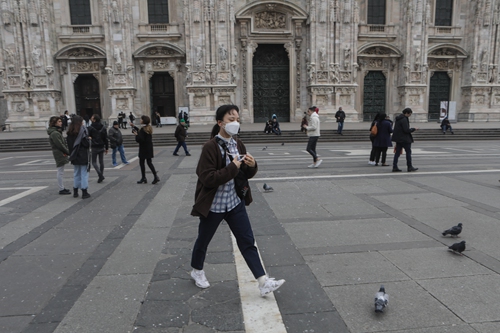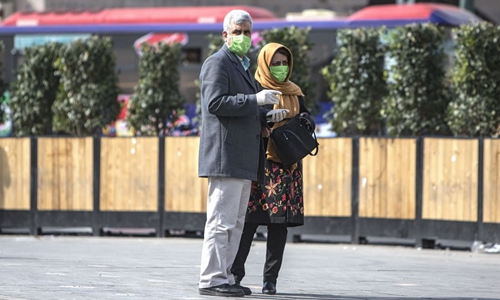HOME >> CHINA
How big a threat are imported infections? GT's exclusive research into the risks
By Global Times staff reporters Source:Global Times Published: 2020/3/6 19:07:22 Last Updated: 2020/3/7 0:36:31
China alerted to mind more countries in Asia, Europe on brink of virus

A woman tourist, wearing a protective mask, walks on Piazza Duomo in Milan, Italy on Tuesday. Photo: AFP
China's National Health Commission on Friday announced that 16 out of the 17 new COVID-19 cases in China (outside of Hubei Province) reported on Thursday were infections of foreign origin - 11 were detected in Gansu Province from Iran, four in Beijing from Italy and one in Shanghai from Iran, further worrying the public of the risk of infections from overseas.Shanghai on Friday reported three more imported cases of COVID-19 by noontime from Iran, and Shenzhen in Guangdong Province on Friday reported the city's second imported case, from Spain, bringing the total number of imported infections to 40 nationwide.
While China's efforts to prevent and control the coronavirus have scored remarkable effects, new warnings are being issued overseas with ascending numbers of infections reported every day, making the risk of imported outbreaks in China an urgent issue.
Officials from East China's Zhejiang Province said on Friday it will put preventing imported cases of COVID-19 as a top priority. Zhejiang so far reported 1,215 cases of coronavirus infection as of Friday morning, within which 10 cases were of foreign origin.
Media reported all of the imported cases these days are sent directly from airports to designated places, which demonstrates China's more robust precaution system.

South Korean soldiers wearing protective gear spray disinfectant on the street to help prevent the spread of the COVID-19, at Gangnam district in Seoul on Thursday. Photo: AFP
In addition to countries that are being haunted by coronavirus which include Italy, Iran, South Korea and Japan, China should also pay attention to other countries including Kuwait, Bahrain, Thailand and Cambodia, and also parts of Europe, Wang Peiyu, associate dean of the School of Public Health at Peking University, told the Global Times.
There are two major ways to prevent imported cases, Wang said. "One is to conduct strict temperature checks and register past travel history at the time of entry. And the other is to urge citizens to avoid going to countries with major outbreaks."
Over a period of 24 hours on March 2, there were a total of 420 flights between China and 32 countries, including 85 flights between China and South Korea, and the flight conducting rate was down to 23.10 percent, according to a flight chart sent to the Global Times by domestic aviation data provider Feeyo Technology Co.
There were only two round-trip flights between China and Iran during the same period, 57 between China and Japan, and 17 between China and the US. Other countries have more flights operating China routes including Thailand with 83 flights, Cambodia with 41 and Malaysia with 19.
Data also showed that from February 25 to Tuesday, the majority of flights arriving in China from South Korea landed in Beijing, Qingdao in East China's Shandong, Shenyang in Northeast China's Liaoning, and Yanji in Northeast China's Jilin. Most flights from Japan arrived in cities including Shanghai, Beijing, Guangzhou in South China's Guangdong and Dalian in Liaoning.
Domestic airports have strengthened the management of arrivals from countries and regions with severe epidemic situations, according to documents the Global Times obtained from several airports.

A couple wearing masks are seen in downtown Tehran, Iran, Feb. 23, 2020. Photo: Xinhua
For instance, the Xiamen airport requires all airlines to register, collect data from passengers and screen all those who have been to countries including Japan, South Korea, Iran, Italy and Singapore in the past 14 days. Zhejiang's airport requires airlines to inform destination airports in advance of transited flights from Japan, South Korea, Iran and Italy, as imported infections have recently entered China via transit locations like Moscow airport.
Currently, China faces several battlefields as it is a highly globalized economy and it is impossible to ban all visitors from entering, Chen Xi, an assistant professor of public health at Yale University, told the Global Times.
"The most important task is to quickly identify risks at the entry point. The government can also consider requisitioning some facilities near major airports for the purpose of implementing quarantines for passengers with higher risks," Chen said.
On Thursday, the number of new confirmed cases of COVID-19 in China was 143 (126 in Hubei, the epicenter of the outbreak), while the WHO reported on Thursday (local time) that a total of 14,768 new cases of the coronavirus had been confirmed in 85 countries outside China, with a total of 267 deaths. Statistics from National Customs showed that before Thursday, a total of 6,728 passengers entering China had shown symptoms, of whom 779 became suspected cases and 75 later tested positive for the virus through nucleic acid testing.
How big is the risk of imported coronavirus? Where are imported cases coming from? The Global Times has exclusively investigated the situation on the ground in Italy, Iran, South Korea, Japan, the US and France to find answers:
Lax policies in Italy worry Chinese
"Italians are still singing songs and dancing [without being influenced by the coronavirus], but the Chinese are horrified," said Li Na, a Chinese national who runs a bar in Italy...
To leave Iran, S.Korea or not
Zhang Ming (pseudonym) returned to China from Iran on a chartered flight on Wednesday. He told the Global Times that he had been studying and living in the holy city of Qom, one of the worst-hit cities in Iran. As more and more deaths were reported in Iran, he became increasingly nervous as the country's medical facilities are not good...
Risks rise in France, US
France, Germany, Spain and the US are considered countries where outbreaks are increasing in severity. Take France as an example. Cao Huaqin, a businessman from East China's Fujian Province who lives in France, told the Global Times...
Newspaper headline: How big a threat are imported infections?
Posted in: SOCIETY